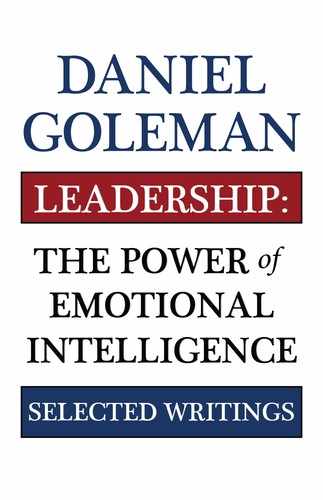THE SOCIAL BRAIN
Adapted from The Brain and Emotional Intelligence: New Insights
We are constantly impacting the brain states in other people. In my EI model, “Managing relationships” means, at this level, that we’re responsible for how we shape the feelings of those we interact with – for better or for worse. In this sense, relationship skills have to do with managing brain states in other people.
This raises a question. Who sends the emotions that pass between people, and who receives them? One answer, for groups of peers, is that the sender tends to be the most emotionally expressive person in the group. But in groups where there are power differences – in the classroom, at work, in organizations generally – it is the most powerful person who is the emotional sender, setting the emotional state for the rest of the group.
In any human group, people pay most attention to – and put most importance on – what the most powerful person in that group says or does. There are many studies that show, for example, that if the leader of a team is in a positive mood, that spreads an upbeat mood to the others and that collective positivity enhances the group’s performance. If the leader projects a negative mood, that spreads in the same way, and the group’s performance suffers. This has been found for groups making business decisions, seeking creative solutions – even erecting a tent together.
Such emotional contagion happens whenever people interact, whether in a pair, a group, or an organization. It’s most obvious at a sporting event or theatrical performance, where the entire crowd goes through the identical emotion at the same time. This contagion can happen because of our social brain, through circuitry like the mirror neuron system. Person-to-person emotional contagion operates automatically, instantly, unconsciously and out of our intentional control.
There was a study done at Massachusetts General Hospital of doctors and patients during a psychotherapy session. The interaction was videotaped and their physiology was monitored. Afterwards, the patients reviewed the tape, identifying moments when they felt the doctor empathized with them – when they felt heard and understood, in rapport with the doctor, versus feeling really disconnected, thinking: “My doctor doesn’t get me, doesn’t care about me”. In those moments where patients felt disconnected, there was no connection in their physiology, either. But at those moments when the patient said, “Yes, I felt a real connection with the doctor,” their physiologies moved in tandem, like a dance. There was also a physiological entrainment, with the doctor and patient’s heart rates moving in tandem.
That study reflects the physiology of rapport. There are three ingredients to rapport. The first is paying full attention. Both people need to tune in fully to the other, putting aside distractions. The second is being in synch non–verbally. If two people are really connecting well, and you were to observe that interaction without paying attention to what they were saying (like watching a film with no soundtrack), you’ll see their moves are almost choreographed, like a dance. Such synchrony is orchestrated by another set of neurons, called oscillators, which regulate how our body moves in relationship to another body (or any object).
The third ingredient of rapport is positive feeling. It’s a kind of micro–flow, an interpersonal high. These moments of interpersonal chemistry, or simpatico, are when things happen at their best – no matter the specifics of what we’re doing together.
An article in the Harvard Business Review calls this kind of interaction a “human moment.” How do you have a human moment at work? You have to put aside whatever else you’re doing, and pay full attention to the person who’s with you. And that opens the way to rapport, where emotional flow is in tandem. When your physiology is in synchrony with someone else you feel connected, close and warm. You can read this human moment in terms of physiology – but you can also read it experientially, because during those moments of chemistry we feel good about being with the other person. And that person is feeling good about being with us.
